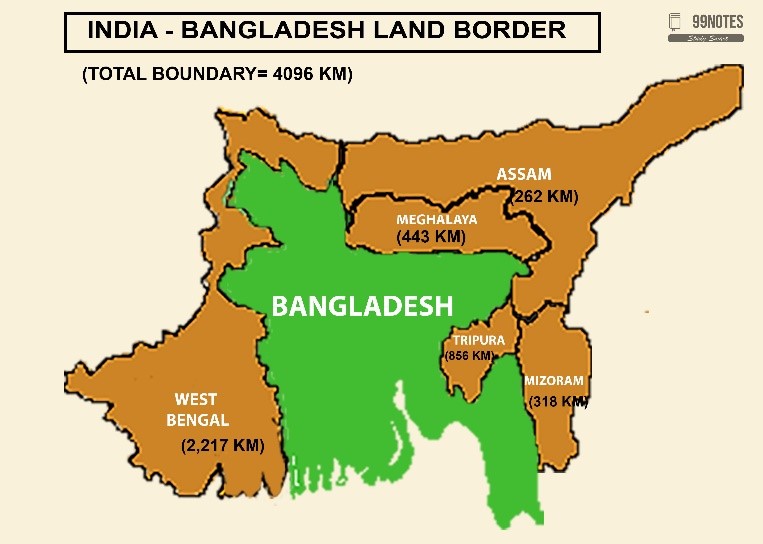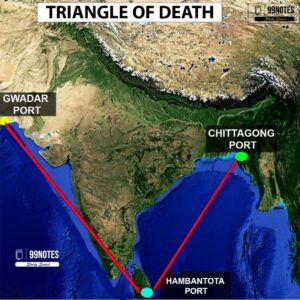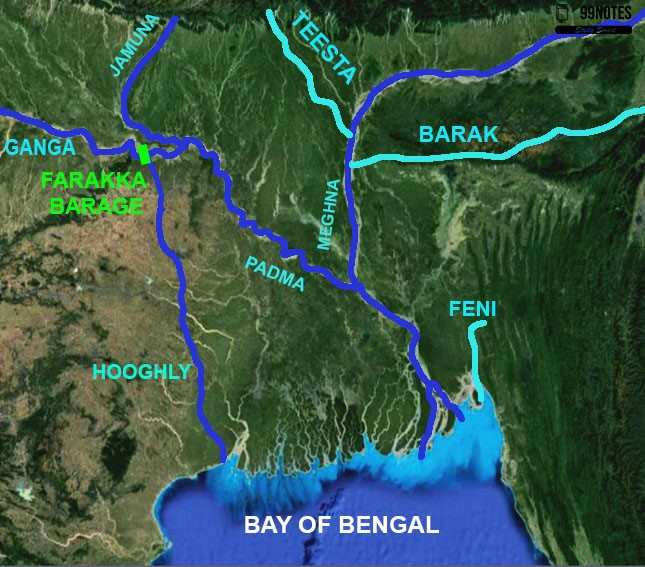India-Bangladesh
Introduction:
India and Bangladesh share bonds of rich historical ties, including language, trade relations and culture. The bilateral ties reflect an all-encompassing partnership based on equality, sovereignty, trust, and understanding that goes far beyond a strategic partnership. Both countries view each other as important partners in realizing respective national development visions of “Viksit Bharat 2047” and “Smart Bangladesh Vision 2041”. Bangladesh was invited as a guest country to G20 Summit, which was held in India’s Presidency in 2023.
Historical Evolution of the Relationship:
India played an essential role in the formation of Bangladesh. India was the first nation to recognize Bangladesh as an independent and separate state and established diplomatic relations with the country immediately after its independence in December 1971.
- Under the leadership of Sheikh Mujibur Rahman, the Awami League (AL) won the national parliamentary elections of Pakistan in 1970. Still, President Yahya Khan annulled the results, cracked down on Bengalis in East Pakistan and arrested Sheikh Mujib in 1971. After the 1971 War of Liberation, the Awami League(AL) formed the government.
- The support from India was immense in Bangladesh’s war of liberation in contrast with China’s backing for Pakistan, which strengthened the ties between the two countries. Sheikh Mujibur Rahman’s Awami League emerged victorious in the first general elections.
- The Awami League under Sheikh Hasina won the 2018 general elections and formed the government. Again, in 2024, the Awami League emerged victorious and formed the government.
- Under her term in power, the relationship between the two countries has been extremely fruitful in strengthening the ties, most of the border issues have been sorted, economic cooperation has been furthered, and most importantly, Hasina has firmly supported India’s national security interests.
- While the regime under Khaleda Zia’s BNP, Bangladesh became a safe haven for terrorist and militant outfits with anti-India designs.
Importance of Bangladesh to India:
Geopolitical
- Bangladesh shares the most extensive land border with India, which is almost 4096 kilometres. There also exists a maritime boundary between the two nations.

- Bangladesh is located between South and Southeast Asia and is pivotal for India’s Act East Policy, which aims to build closer ties with Southeast Asian countries.

- Support from Bangladesh is important for strategic dominance in the Indian Ocean Region and to counter the three Chinese-run ports in South Asia, i.e., Chittagong in Bangladesh, Hambantota in Sri Lanka, and Gwadar in Pakistan. This is called a “triangle of death”, which encircles India.
Security Perspective:
- Bangladesh has helped in fighting North-East insurgent groups. For instance, it aided in neutralizing the ULFA groups.
- Joint patrolling of India and Bangladesh has ensured the curbing of piracy operations in the region.
- Bangladesh can help New Delhi against Chinese expansionism in the subcontinent region.
- Both nations have collaborated in fighting human and drug trafficking and illegal wildlife trade.
Environmental Concerns:
Both countries share transboundary Rivers and ecological systems, making it significant for the two nations to cooperate on issues such as flood water and water management.
Indian Ocean Region:
The location of Bangladesh also empowers it to play a critical role in the affairs of the IOR, and the Bangladeshi Navy has to play a part in ensuring that sea lanes of communications are free of pirates and others who threaten maritime commerce.
Area of Convergence:
Security and Border Management:
- There is activecooperation between various agencies in both countries working jointly to combat illicit drug trafficking, fake currency, human trafficking, cooperation in anti-corruption activities, etc.
| Land Border Agreement |
|
After the partition of India in 1947, the Radcliffe line became the border between India and East Pakistan. After the liberation of Bangladesh in 1971, the same line became the border between India and Bangladesh. However, the demarcation was delayed due to difficulties in determining the boundary. Various measures have been taken to solve the issues as follows:
|
Maritime Boundary between India and Bangladesh: The partition of India and Pakistan in 1947 resulted in ambiguous demarcation of the maritime borders. India and Bangladesh took it to the Permanent Court of Arbitration (PCA), which was authorized under the United Nations Convention on Law of Sea in 2009. It gave its verdict in 2014, which was accepted by both countries.
Defence and Strategic Cooperation:
- The Mukti Bahini, the Bengali guerrilla force trained in camps in India, is part of a shared political heritage.
- Defence procurement: India has provided USD 500 million Line of Credit to Bangladesh for defence-related procurement in the neighbouring country. Bangladesh has agreed to increase its purchases of Indian-developed weapon systems to diversify its military suppliers.
- Bangladeshi help uproots insurgency: It has uprooted anti-India insurgency from its borders, making the India-Bangladesh border one of the region’s most peaceful.
- India provides military equipment technology transfer and also exports weapons to Bangladesh.
- Both countries conduct joint military exercises such as SAMPRITI and joint naval exercises in Milan. It fosters close military cooperation and improves interoperability.
- Both have reiterated their commitment to a free, open, inclusive, secure, and rules-based Indo-Pacific region.
- India and Bangladesh are working together on global platforms to promote their common interests, particularly those of the Global South. Second session of Voice of the Global South Summit organized by India in 2023.
- The successful launch of the South Asia Satellite (SAS) to boost communication and improve disaster links among its six neighbours has opened new horizons of engagement in the region.
Economic and commercial:
- Bangladesh is India’s biggest trade partner in the South Asian region, and India is the second biggest trade partner of Bangladesh.
- Bangladesh exported goods worth 1.97 billion dollars to India in FY 2023-24. In FY 2023-24, the total bilateral trade has been reported as USD 14.01 billion.
- India-Bangladesh Startup Bridge: India and Bangladesh are engaging in new areas of cooperation. For example, cooperation in startups has been started. India-Bangladesh Startup Bridge was inaugurated by the Prime Minister of both countries in March 2021. In this delegation of startups, both countries visit each other.
- MoUs in the areas of digital payment mechanisms and agricultural research were signed between the two countries in November 2023.
- India wants to move forward with greater economic engagement with the Comprehensive Economic Partnership Agreement (CEPA) and has called for greater cooperation between countries in areas such as defence and pharmaceutical production.
Infrastructure
Connectivity projects:
- Railway connectivity: There has been rehabilitation of 6 pre-1965 rail links between India and Bangladesh. PM of both countries has inaugurated the 6th cross-border rail link between Agartala station in India and Akhaura in Bangladesh on 1st November 2023.
Other rail links include:
- Haldibari (India) – Chilahati (Bangladesh)
- Petrapole (India)-Benapole (Bangladesh),
- Gede (India) – Darshana (Bangladesh),
- Singhabad (India) – Rohanpur (Bangladesh), and
- Radhikapur (India) – Birol (Bangladesh).
- Currently, three railway trains operating between the two countries are the Maithri Express, Bandhan Express and Mitali Express.
- Road and Inland Water Connectivity: India and Bangladesh have a Protocol on Inland Waterways Trade and Transit (PIWTT), which has been operational since 1972. It will facilitate trade and transit between the two countries through the inland waterways.
- Port Connectivity: There has been an Agreement for the usage of Chittagong and Mongla Ports in 2023. This will help transport cargo between Northeast and mainland India.
- Bangladesh, Bhutan, India and Nepal (BBIN) project is expected to improve connectivity and boost trade in the South Asian region by more than 60%.
Cooperation in the power and energy sector:
- Both countries signed the India-Bangladesh Friendship Pipeline in 2023, the firstcross-borderenergy pipeline for the carriage of high-speed diesel between Siliguri-Parbatipur.
- ONGC Videsh Limited (OVL), in a consortium with Oil India Limited, is present in off-shore oil exploration. IOCL was also registered as a G2G supplier in 2023 and supplies POL products to Bangladesh.
- India currently exports 1,160MW of electricity to Bangladesh. The NTPC built 1320 MW thermal power plants at Rampal in 50:50 joint ventures. A 1600 MW power plant in Godda, Jharkhand, built by the Adani group, will supply power to Bangladesh.
- The Maitree super thermal power plant project, built under an Indian concessional financing scheme loan of $1.6 billion, is a 1,320 MW plant located at Rampal at Khulna.
- The Rooppur nuclear plant will produce a 2400MW project with Indo-Russian assistance.
- Development Partnership: Bangladesh is India’s largest development partner today. India has extended 3 Lines of Credits (LOC) worth 8 billion dollars to Bangladesh in the last eight years. High-impact Community Development projects (HICDPs) constitute an active pillar of India’s development assistance.
People-to-People Ties:
- Shared History/Cultural Heritage: Rabindranath Tagore composed the national anthems of India and Bangladesh. ‘Amar Sonar Bangla’ was written after the partition of Bengal. India participated in the 1971 birth of Bangladesh.
- Cultural cooperation: The Indira Gandhi Cultural Centre in Dhaka plays an important role in celebrating common cultural links between the two countries. It helps to promote people-to-people contacts.
- Tourism: Bangladeshis make up a large portion of India’s tourists, especially in medical tourism. In 2019-20, the majority of 54% were from Bangladesh, according to the data released by India’s Ministry of Tourism.
- Capacity Building and Human Resources Development: An importantITEC partner country, Bangladesh annually sees around 800 participants availing benefits of the ITEC training courses. In March 2021, India announced 1000 “Suborno Jayanti Scholarships” for Bangladeshi students.
Regional Cooperation:
Both the countries are also engaged in regional cooperation through multilateral forums, for instance, IORARC (Indian Ocean Rim Association for Regional Cooperation), SAARC (South Asian Association for Regional Cooperation) and BIMSTEC (Bay of Bengal Initiative for Multi-sectoral Technical and Economic Cooperation), which connects the Eastern Subcontinent with Myanmar and Thailand.
Area of Divergence:
Divergence over water sharing:
- Farraka Barrage: Bangladesh is against the Farakka Barrage, which was constructed to increase the water supply in the Hoogly River. Bangladesh claims this barrage is against sharing the Ganga water agreement signed in 1996.
- Teesta River Dispute: the Teesta River is a major source of irrigation for the paddy growing in the greater Rangpur region of Bangladesh. Bangladesh has sought equitable distribution of Teesta waters on the lines of the Ganga Water Treaty of 1996, but the agreement has not been resolved due to objections from the West Bengal government.
| Water Sharing Agreements between India-Bangladesh | ||||||||||||
|
Indo-Bangladesh Joint Rivers Commission (JRC) was established to maintain liaisons in order to ensure joint efforts to maximize the benefits of common river systems. Water Resources Ministers of both the countries head it. It has helped in cooperation in various cross-border rivers as follows: The Ganga Water Agreement signed in 1996
Agreement for Barak River: India and Bangladesh agreed in September 2022 to share the Kushiyara River’s water, which is a distributary of the Barak River. This will benefit Sylhet in Bangladesh and facilitate water projects in South Assam in India. Agreement for Feni River: In 2019, Bangladesh had agreed to let India withdraw 1.82 cusecs of water from the Feni River for drinking purposes, meant for the people of Sabroom town in Tripura. |
Border Dispute:
- Problem over boundary demarcation: There are long-standing border disputes between two nations over the demarcation of shared borders, particularly in Assam and Tripura.
- Illegal Migration: the mass exodus of more than one million Rohingyas since 2017 and their infiltration to India via Bangladesh is a serious threat to peace and security in the region.
- Drug smuggling and trafficking: there have beenmany incidences of cross-border drug smuggling and trafficking. Humans (children and women) are trafficked, and various animal and bird species are poached through these borders.
Other Issues
- Terrorism: The India-Bangladesh border is susceptible to terrorist infiltration. Various outfits like jamaat-ul Mujahideen Bangladesh are trying to spread their tentacles across India.
- Dispute over National Register of Citizens (NRC): It has left out 1.9 million people in the Assam region, and they are being labelled as illegal immigrants from Bangladesh region. But Bangladesh is firm in its stand that no migrants travelled to Assam state illegally during the War of Independence in 1971, and NRC may risk the relations.
Area of Conflict
There are various areas of conflict between India and Bangladesh as follows:
- Insurgency: India accused Bangladesh of using its porous border to support insurgency groups such as the United Liberation Front of Assam (ULFA).
- Flow of Migrants: The flow of migrants across Bangladesh’s boundary due to unstable conditions in Bangladesh has also caused tension between the two nations. The large influx of such migrants across the boundary has posed serious socio-economic and political problems for the people of Indian states bordering Bangladesh Viz, Tripura, Assam, Meghalaya, Mizoram, and West Bengal.
- Geopolitical issues: Investment in China has been increasing in Bangladesh, especially in infrastructure development, energy, telecommunications, etc., such as the BRI and Investment in Chittagong port.
- Connectivity Issue: Lack of proper infrastructure, connectivity, and cooperation hinders the development of economic ties between the two countries. For Instance,
- Bhutan has opted out of BBIN, and planning and implementation are slow.
- Illegal smuggling is due to a lack of valid approaches to business, such as adequate numbers of Integrated Check Posts (ICPs).
- Delay in development projects: delayed projects, under-utilizedcredit mostly due to red tape from India’s end, and slow project implementation on Bangladesh’s end.
- Relationship with China: raises certain security concerns
- China has announced tariff exemption for 97% of exports from Bangladesh. Diplomatic sources in Bangladesh have described the Chinese move as a “major success” in the Dhaka-Beijing relationship.
- Chinese projects: part of the One Belt, One Road initiative
Way forward:
- Interlinking of rivers: India can interlink rivers to provide more water to the Teesta catchment from Eastern rivers such as Manas. India can help Bangladesh build its own canals to use water optimally.
- Illegal immigration and NRC issue: this has to be resolved at the diplomatic level. India would need to explain to Bangladesh that India’s NRC does not affect Bangladesh.
- Rohingyas Issue: India has to take the Rohingyas issue with Myanmar to address the joint concerns and reduce the influx of refugees.
- Illegal Immigration: Both countries can propose a SAARC declaration on refugees in the SAARC, laying down a specific procedure for determining the status of refugees.
- Countering China: India can partner with like-minded countries to invest in assisting Bangladesh with critical technologies and financial assistance to counter Chinese investment.
- Steps to correct trade imbalance: Allow duty-free trade from Bangladesh, given that China has already offered duty-free import on 97% of items.
- Cooperation on international borders: Mechanisms should be developed for the peaceful and cooperative management of the international border, mainly focussing on border fencing, joint inspection of boundary pillars, etc.
- Border Killing: India needs a comprehensive strategy and automated border fence guarding system to allow minimal human interaction and maximum security from illegal cross-border trade.
- Finalizing CEPA: the proposed CEPAshould be finalized as soon as possible to strengthen economic cooperation between the two.






![Swadeshi Movement (1905): Overview, Causes & Impact [UPSC Notes] | Updated April 1, 2025 Swadeshi Movement (1905): Overview, Causes & Impact [UPSC Notes]](https://www.99notes.in/wp-content/uploads/2024/01/swadeshi-movement-featured-66698a5e632b7-768x500.webp)

